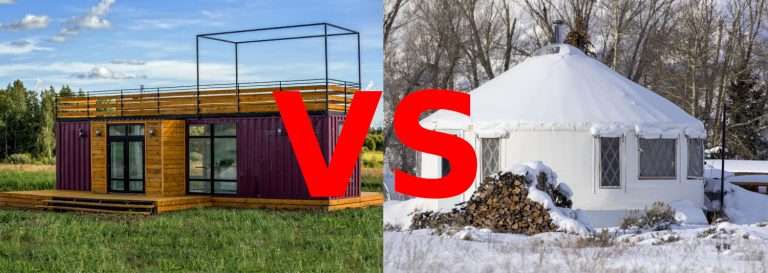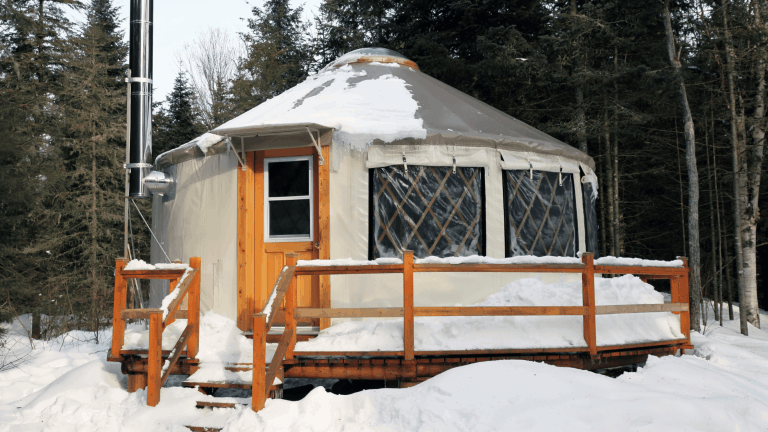What Makes a Good Travel Yurt?
In many ways the life of a nomad sounds appealing: Living free and moving from place to place to follow the seasons or perhaps for new experiences. Of course, in most of the world, a traditionally nomadic lifestyle is no longer legal or feasible, but we can still travel and set up temporary homes on public and, occasionally, private land. We can be modern nomads.
Many traditionally nomadic peoples lived (and still live) in tents, yurts, or yurt-like structures. Yurts are heavier than tents and take longer to set up, but they are more sturdy and offer the benefits of greater protection against the elements and a more “homey” feeling.
But what is the best yurt for traveling? Many modern yurts are large, heavy structures that are not really made to be moved about. They can be taken down and moves, but it’s a significant task that is not suitable for a life on the move.
The best yurt for traveling is a lightweight version of the original yurts used by Mongolian nomads. A travel-friendly yurt is characterized by:
- maximum 500 sq. ft. and preferably less than 300 sq. ft.
- no windows and only a small door
- only flexible lattice walls
- light-weight yurt covers
Should You Get a Tent Instead of a Yurt?
If you plan on moving very often, you may prefer a tent. Tents don’t offer the same level of comfort, but they are a lot easier to set up and dissemble. In general, if you plan on moving less than once a month, a tent is often preferable.
Another somewhat related question is how you will be traveling. Even a light yurt is heavy in comparison to a tent. While a 4 person tent weighs between 6 and 12 pounds, a small yurt weighs at least 80 pounds. However, you can lower that weight significantly with a little creativity. More about that later.
How Big Should a Travel Yurt be?
Mongolian nomadic yurts are most often between 300 and 500 square feet in size. Note, that nomadic people travel in groups of two or more families and they are able to help each other with setting it up. If you travel alone, you will want to get the smallest possible yurt.
A small yurt is around 125 square feet. That is still a significant size compared to most tents, which is their upside. Yurts are measured by the number of wall panels (khana). Small yurts have only three panels while large versions have around 7. Bigger models do exist, but they generally not a realistic option for traveling.
Use Lightweight Materials
If you want a light and travel-friendly yurt, use thinner materials, such as nylon covers along with lightweight lattice walls. Solid traditional wool felt is nice to have but it’s also much heavier. Of course, you will not have the same level of insulation but will still be able to enjoy the comfort of a dry and relatively large indoor space.
Another factor is your heat source. Most yurts are heated by wood stoves which are perfect for off-grid heating. Use a lightweight stove such as the YILI Outdoor Camping Stove as it is easy to install and easy to move. This stove has less mass than the heavy stoves intended for permanent installations and will not stay warm as long, but they are more than adequate for heating a smaller space.
Get a Yurt That Is Easy to Assemble
Unless you are a group of people traveling together, stick to a yurt with a very basic (traditional) design: lattice walls, roof rafters, roof wheel, covers, and a door. With a bit of experience, you should be able to set it up in about half an hour to an hour.
Avoid solid walls, windows, etc. There are good reasons why nomadic peoples use flexible materials and simple designs. Not only do such luxuries add weight, but they also make it much more complicated to set up your yurt within a reasonable timeframe. Solid and rigid materials are also much more cumbersome to transport.
Transportation
Since yurts are relatively heavy, moving them from one location to another is not as simple as carrying one in a backpack or even inside the trunk of a smaller car. Thus one important consideration is the mean of transportation?
Therefore, consider how intent to transport your yurt. A truck bed or perhaps a trailer are both good options. A good off-road truck can carry a reasonably-sized yurt and will allow you to explore the less-traveled places in nature.
How Often Will You Be Travelling?
One last and important consideration is how often you will be moving your yurt. If you break camp every week, it should be very small, but if you stay at the same location for half a year or more, it may be wort it to get a bigger mode.
Unless you plan to live permanently in the yurt, it also needs to be stored away while not in use. While larger, more permanent yurts can easily stay outside during the winter, a lightweight version should be packed down and stored in a protected location.
In the end, it comes down to a relatively simple cost/benefit analysis: How much weight and hassle are you willing to accept for more space and comfort? For traveling purposes, you will have to give up quite a bit of comfort but while some can live in a tiny yurt you may prefer a slightly larger one.



![Do Yurts Get Moldy? [3 Life-Saving Tips!]](https://freedomresidence.com/wp-content/uploads/2022/05/Do-Yurts-Get-Moldy-768x512.jpg)


